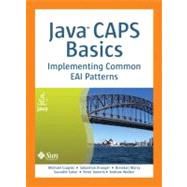
| Preface | p. xiii |
| Acknowledgments | p. xxv |
| About the Authors | p. xxvii |
| Preliminaries | p. 1 |
| Enterprise Integration Styles | p. 3 |
| Introduction | p. 3 |
| File Transfer | p. 3 |
| Database Sharing | p. 4 |
| Remote Procedure Invocation | p. 5 |
| Messaging | p. 6 |
| Service Orchestration | p. 7 |
| Centralized versus Distributed | p. 8 |
| Chapter Summary | p. 11 |
| Java CAPS Architecture | p. 13 |
| Introduction | p. 13 |
| Historical Note | p. 13 |
| Context | p. 14 |
| Java CAPS Architecture | p. 16 |
| Solution Development Stages | p. 20 |
| Chapter Summary | p. 23 |
| Project Structure and Deployment | p. 25 |
| Introduction | p. 25 |
| From Logical Solution to Physical Deployment | p. 26 |
| Project Structure Considerations | p. 26 |
| Backup of Development Artifacts | p. 36 |
| Release Management | p. 40 |
| Deployment Architectures | p. 50 |
| Command-Line Build and Deployment | p. 54 |
| Chapter Summary | p. 56 |
| Patterns Review and Application | p. 57 |
| Message Exchange Patterns | p. 59 |
| Introduction | p. 59 |
| Document Message | p. 60 |
| Command Message | p. 60 |
| Event Message | p. 61 |
| Request/Reply | p. 63 |
| Return Address | p. 76 |
| Correlation | p. 77 |
| Message Sequence | p. 77 |
| Message Expiration | p. 82 |
| Format Indicator | p. 86 |
| Data Streaming | p. 88 |
| Message Security | p. 90 |
| Chapter Summary | p. 91 |
| Messaging Infrastructure | p. 93 |
| Introduction | p. 93 |
| Java Message Service (JMS) | p. 94 |
| JMS Implementation Interoperability | p. 95 |
| Using JMS to Integrate Non-Java Environments | p. 95 |
| Queues versus Topics | p. 96 |
| Sun SeeBeyond IQ Manager | p. 97 |
| Resilient JMS with JMS Grid | p. 119 |
| Competing Consumers | p. 127 |
| Point-to-Point Channel | p. 131 |
| Publish-Subscribe Channel | p. 132 |
| Datatype Channel | p. 132 |
| Invalid Message Channel | p. 136 |
| Dead Letter Channel | p. 136 |
| Guaranteed Delivery | p. 140 |
| Channel Adapter | p. 150 |
| Messaging Bridge | p. 151 |
| Message Bus | p. 157 |
| Chapter Summary | p. 158 |
| Message Routing | p. 161 |
| Introduction | p. 161 |
| Overview | p. 161 |
| Fixed Router | p. 163 |
| Content-Based Router | p. 165 |
| Message Filter | p. 168 |
| Recipient List | p. 169 |
| Splitter | p. 171 |
| Aggregator | p. 172 |
| Resequencer | p. 173 |
| Composed Message Processor | p. 175 |
| Scatter-Gather | p. 175 |
| Routing Slip | p. 176 |
| Process Manager | p. 177 |
| Message Broker | p. 177 |
| Chapter Summary | p. 178 |
| Message Construction | p. 179 |
| Introduction | p. 179 |
| Message | p. 179 |
| Object Type Definitions | p. 180 |
| Envelope Wrapper | p. 188 |
| Chapter Summary | p. 202 |
| Message Transformation | p. 203 |
| Introduction | p. 203 |
| Envelope Wrapper | p. 203 |
| Content Enricher | p. 203 |
| Content Filter | p. 204 |
| Claim Check | p. 205 |
| Normalizer | p. 206 |
| Canonical Data Model | p. 207 |
| Chapter Summary | p. 208 |
| Messaging Endpoints | p. 209 |
| Introduction | p. 209 |
| Messaging Gateway | p. 209 |
| Transactional Client | p. 210 |
| Polling Consumer | p. 211 |
| Event-Driven Consumer | p. 216 |
| Competing Consumers | p. 217 |
| Message Dispatcher | p. 218 |
| Selective Consumer | p. 219 |
| Durable Subscriber | p. 219 |
| Idempotent Receiver | p. 220 |
| Service Activator | p. 223 |
| Chapter Summary | p. 225 |
| System Management | p. 227 |
| Introduction | p. 227 |
| Java CAPS Monitoring and Management | p. 227 |
| Solution-Specific Management | p. 317 |
| Chapter Summary | p. 331 |
| Specialized Java Caps Topics | p. 333 |
| Message Correlation | p. 335 |
| Introduction | p. 335 |
| Overview | p. 336 |
| JMSCorrelationID | p. 337 |
| eInsight Correlations | p. 337 |
| eInsight Correlation Processor: First Cut | p. 338 |
| Correlation Identifier | p. 343 |
| eInsight Correlation Processor: Second Cut | p. 344 |
| Derived Correlation Identifiers | p. 349 |
| Derived Correlation Identifiers: Alternative | p. 354 |
| Table of Contents provided by Publisher. All Rights Reserved. |
The New copy of this book will include any supplemental materials advertised. Please check the title of the book to determine if it should include any access cards, study guides, lab manuals, CDs, etc.
The Used, Rental and eBook copies of this book are not guaranteed to include any supplemental materials. Typically, only the book itself is included. This is true even if the title states it includes any access cards, study guides, lab manuals, CDs, etc.